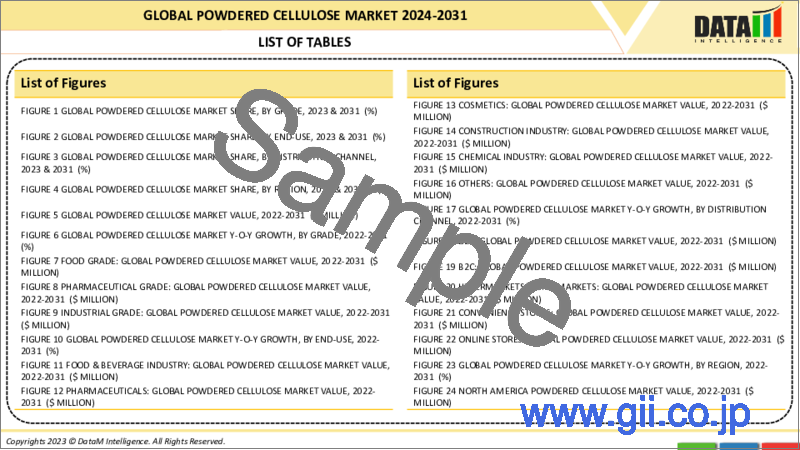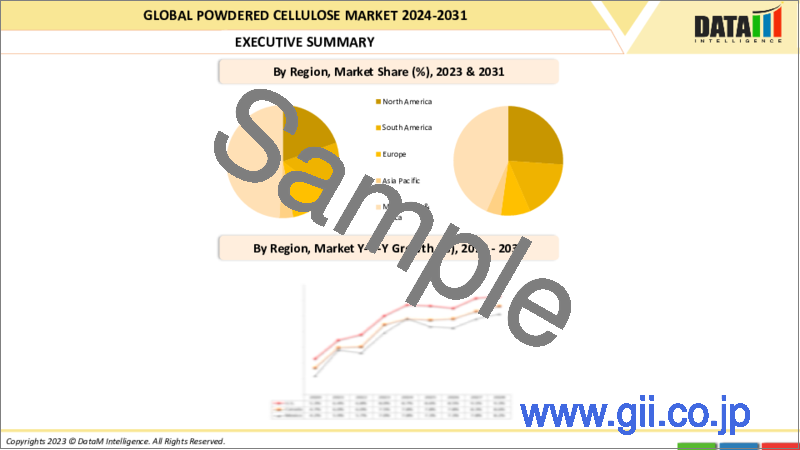|
|
市場調査レポート
商品コード
1247415
粉末セルロースの世界市場-2023-2030Global Powdered Cellulose Market - 2023-2030 |
||||||
|
● お客様のご希望に応じて、既存データの加工や未掲載情報(例:国別セグメント)の追加などの対応が可能です。 詳細はお問い合わせください。 |
|||||||
| 粉末セルロースの世界市場-2023-2030 |
|
出版日: 2023年03月28日
発行: DataM Intelligence
ページ情報: 英文 200 Pages
納期: 約2営業日
|
- 全表示
- 概要
- 目次
市場概要
セルロースは、様々な用途に使用できる、白色で無味の粉末です。セルロースは、微結晶、カルボキシメチル、粉末の3種類の形状があります。生の植物繊維を様々な化学薬品で調理して、セルロースパウダーを製造します。セルロースパウダーを使用した食品は、液状から糊状まで、さまざまな食感を持つ。水や他の液体溶媒に溶けやすいので、粉末セルロースはさまざまな産業で使用することができます。粉末セルロースは、医薬品、化粧品、飲食品、繊維、製紙など、さまざまな産業で使用されています。食品、化粧品、医薬品などの需要は増加すると予想され、粉末セルロースの市場を活性化させるでしょう。粉末セルロースの需要は、飲食品、化粧品、その他の産業における用途の拡大により、世界的に上昇すると考えられます。
粉末セルロースの世界市場は、予測期間中(2023-2030年)CAGR7.89%で成長すると予測されています。
市場力学:健康を重視する消費者に粉末セルロースが受け入れられつつあることが、市場拡大の原動力となっている
粉末セルロースは、さまざまな産業で数多くの用途に使用されています。健康志向の人々が粉末セルロースの需要を押し上げると予測されています。粉末セルロースは、栄養補助食品や食物繊維サプリメントとして使用されるほか、食物繊維の含有量を高めるために食品に添加されます。粉末セルロースは水とよく混ざり合うので、プロテインドリンクやその他のエナジードリンクによく添加されます。粉末セルロースは、カロリーが低く、減量に役立つことから、ダイエット食品に使用されています。セルロースを増量剤として使用することで、たくさん食べても満腹感が得られるため、体脂肪を減らしてダイエットをサポートします。また、粉末セルロースは、コレステロールや血圧の調整にも役立ちます。粉末セルロースの需要は、健康的なダイエット食品への需要の高まりにより、予測期間中に増加すると予想されます。また、ペットフードや動物用飼料の市場でも、粉末セルロースの需要が増加すると予想されます。粉末セルロースは、製品の食感の劣化を防ぐため、テクスチャーライザーとしても採用されています。さらに、粉末セルロースは、製薬業界で錠剤やカプセルなどの剤形に広く使用されています。また、化粧品やスキンケア製品では、増粘剤や吸着剤として使用されています。
一方、飲食品分野では、グルテンフリー食の人気が高まっています。グルテン過敏症のため、多くの消費者はグルテンを含む製品を避けようとします。食品用セルロースは、グルテンフリーのパンの製造に使用されています。グルテンフリーパンの弾力性、ボリューム、安定性、保湿性を高めるために、カルボキシメチルセルロースが主に製造に使用されます。世界のグルテンフリーの食事パターンの人気は、食品用セルロースの需要を増加させるでしょう。
しかし、粉末セルロース市場の成長は、粉末セルロースに含まれる危険な人工保存料の存在や、化学的に発酵させた粉末セルロースの栄養成分の欠如がもたらすさまざまな健康への悪影響によって抑制されると予想されます。しかし、粉末セルロースの市場は、多くの代替品が入手可能であることや、防腐剤の使用に対する健康上の懸念が高まっていることから、課題に直面すると予想されます。
市場セグメンテーション:粉末セルロースの世界市場では、医薬品分野が最も高いシェアを占めています
粉末セルロースの最大の最終用途は医薬品分野です。錠剤やカプセルには、結合剤や賦形剤として粉末セルロースが含まれています。また、充填剤として注射液に配合されることもあります。粉末セルロースの2番目に大きな最終用途産業は化学産業です。塗料、接着剤、シーラントなどは、増粘剤、乳化剤、安定剤として粉末セルロースを使用する化学製品のほんの一例です。多糖類でできたポリマーが粉末セルロースです。ドラッグデリバリーシステムの構築・開発にポリマーが導入されたのは、高分子科学と薬学が融合した結果です。
一方、食品用セルロースは、予測期間中に最も速いCAGRで成長すると予想されています。食品用セルロースは、パルプ化したセルロースを破砕した白色からやや黄色がかった粉末です。サラダドレッシング、クリームチーズ、サワークリーム、ヨーグルト、アイスクリーム、焼き菓子など、さまざまな食品に、固化防止剤、乳化剤、増粘剤として使用されています。また、低脂肪食品の脂肪の代わりとして使用することも可能です。
地域別普及率:予測期間中、欧州が圧倒的なシェアを占める
欧州は、食品用および工業用粉末セルロースの主要な生産者および消費者であるため、予測期間中、最もCAGRが高く、支配的な地域です。欧州の粉末セルロースの最大市場はドイツです。食品用と工業用の粉末セルロースが広く生産され、消費されています。さらに、ドイツは医薬品に使用される粉末セルロースの重要な輸出国です。国際貿易に関する米国COMTRADEデータベースによると、ドイツのインドへのセルロースとその化学誘導体の輸出は、2021年に4,363万米ドルでした。OECDによると、ドイツは2020年にセルロースの世界第2位の輸出国であり、10億5,000万米ドルを海外に送っています。セルロースは同年、ドイツの228番目に輸出された商品としてランク付けされました。米国(1億300万米ドル)、フランス(6,860万米ドル)、ポーランド(6,480万米ドル)、トルコ(6,090万米ドル)、イタリア(5,940万米ドル)はドイツのセルロース輸出市場の上位を占めています。ドイツは2020年、世界第4位のセルロース輸入国となり、2億8,700万米ドルをもたらしました。セルロースは、同年にドイツで503番目に多く輸入された製品です。日本(8,120万米ドル)、米国(5,790万米ドル)、オランダ(3,540万米ドル)、韓国(1,450万米ドル)、英国(1,170万米ドル)はドイツがセルロースを輸入する主要国です。
一方、アジア太平洋地域は、予測期間中に最も急速に市場が成長すると予想されています。アジア太平洋地域の粉末セルロースの最大市場は中国です。この国は、食品や産業用として使用される粉末セルロースの重要な生産国であり消費国でもあります。また、中国は医薬品の主要な輸出国でもあります。
目次
第1章 範囲と調査手法
- 調査手法
- 市場の範囲
第2章 主な動向と発展
第3章 エグゼクティブサマリー
- グレード別市場内訳
- エンドユーズ別市場内訳
- 地域別市場内訳
第4章 市場力学
- マーケットインパクトのある要素
- ドライバ
- 抑制要因
- 機会
- 影響度分析
第5章 産業分析
- ポーターのファイブフォース分析
- サプライチェーン分析
- 需要サイドと供給サイドの分析
- レギュラトリー・アナリシス
- 技術的な進歩
第6章 COVID-19の分析
- 市場におけるCOVID-19の分析
- COVID-19の市場シナリオの前に
- 現在のCOVID-19の市場シナリオ
- COVID-19以降または将来シナリオ
- COVID-19の中での価格・ダイナミクス
- 需給スペクトル
- パンデミック時の市場に関連する政府の取り組み
- メーカーの戦略的な取り組み
第7章 グレード別
- フードグレード
- 医薬品グレード
- 工業用グレード
第8章 エンドユーザー別
- 飲食品分野
- 医薬品
- コスメティック
- 建設業界
- 化学工業
- その他
第9章 地域別
- 北米
- 米国
- カナダ
- メキシコ
- 南米
- ブラジル
- アルゼンチン
- その他南米地域
- 欧州
- ドイツ
- U.K.
- フランス
- スペイン
- イタリア
- その他欧州
- アジア太平洋地域
- 中国
- インド
- 日本
- オーストラリア
- その他アジア太平洋地域
- 中東・アフリカ地域
第10章 競合情勢について
- 競合シナリオ
- 競合の戦略分析
- 市況分析/シェア分析
- M&A分析
第11章 企業プロファイル
- Cargill, Incorporated
- 会社概要
- 製品ポートフォリオと説明
- 主なハイライト
- 財務概要
- ADM
- Associated British Foods plc
- DSM
- Kerry Group plc
- AAK AB
- British Bakels
- Corbion
- International Flavors & Fragrances Inc
- BASF SE
第12章 DataM
Market Overview
Cellulose is a white, flavorless powder that can be used in various ways. Cellulose comes in three different forms: microcrystalline, carboxymethyl, and powder. Raw plant fiber is cooked in various chemicals to produce cellulose powder. Food products with cellulose powder have different textures, ranging from liquid to gluey. Since it is easily soluble in water and other liquid solvents, powdered cellulose can be used in different industries. Powdered cellulose is used in various industries, including pharmaceutical, cosmetics, food and beverage, textile, and paper. The demand for food, cosmetics, pharmaceuticals, and other goods is anticipated to rise, which will fuel the market for powdered cellulose. The demand for powdered cellulose will rise globally due to the growing uses of the material in food and beverage, cosmetics, and other industries.
The global powdered cellulose market was valued at USD YY million in 2022. It is forecasted to reach USD YY million by 2030, growing at a CAGR of 7.89% during the forecast period (2023-2030).
Market Dynamics: The increasing acceptance of powdered cellulose by consumers who value their health is driving the market expansion
There are numerous uses for cellulose powder across numerous industries. Health-conscious people are predicted to drive up demand for powdered cellulose. In addition to being used as a dietary supplement and a fiber supplement, powdered cellulose is added to food items to raise their fiber content. Since powdered cellulose and water mix well, it is frequently added to protein drinks and other energy drinks. Powdered cellulose is used in diet foods because it has few calories and helps with weight loss. By using cellulose as a bulking agent, a person can feel full without eating a lot of food, which supports weight loss by reducing body fat. Powdered cellulose is also helpful in regulating cholesterol and blood pressure. Powdered cellulose demand is anticipated to rise over the forecast period due to the rising demand for healthy diet foods. The market for pet food and animal feed is also anticipated to see an increase in demand for powdered cellulose. As it prevents the product's texture from degrading, powdered cellulose is also employed as a texturizer. Additionally, cellulose powder is used extensively in the pharmaceutical industry to make tablets, capsules, and other dosage forms. Cellulose powder is a thickening agent and adsorbent in cosmetics and skin care products.
On the other hand, in the food and beverage sector, gluten-free diets are growing in popularity. Due to their gluten sensitivity, many consumers try to steer clear of products that contain it. Food-grade cellulose is used to make gluten-free bread. To increase the elasticity, volume, stability, and moisture retention of gluten-free bread, carboxy methyl cellulose is primarily used in its manufacture. The global popularity of gluten-free eating patterns will increase demand for food-grade cellulose.
However, the growth of the powdered cellulose market is anticipated to be constrained by the various negative health effects brought on by the presence of dangerous artificial preservatives in powdered cellulose and the lack of nutritional content in chemically fermented powdered cellulose. The market for powdered cellulose, however, is expected to face challenges due to the accessibility of many substitutes and rising health concerns about the use of preservatives.
Market Segmentation: The Pharmaceuticals segment accounted for the highest share in global powdered cellulose market
The largest end-use sector for powdered cellulose is the pharmaceutical sector. Tablets and capsules contain powdered cellulose as a binder and excipient. It can also be incorporated into injectable solutions as a filler. The second-largest end-use industry for powdered cellulose is the chemical industry. Paints, adhesives, and sealants are just a few examples of chemical products that use powdered cellulose as a thickener, emulsifier, and stabilizer. A polymer made of polysaccharides is powdered cellulose. The introduction of polymer in the creation and development of drug delivery systems resulted from the fusion of polymer and pharmaceutical sciences.
On the other hand, food-grade cellulose is expected to grow with the fastest CAGR in the forecast period. The food-grade cellulose is a white to slightly yellowish powder that is made from pulped cellulose that has been breached. It is used in a variety of food products, including salad dressings, cream cheese, sour cream, yogurts, ice cream, and baked goods, as an anti-caking agent, emulsifier, and thickener. It can also be used to replace fat in low-fat foods.
Geographical Penetration: Europe is the dominating region during the forecast period
Europe is the dominating region during the forecast period, with the highest CAGR due to the major producer and consumer of food-grade and industrial-grade powdered cellulose in the region. Europe's largest market for cellulose powder is Germany. Powdered cellulose of both food grade and industrial grade is widely produced and consumed in the nation. Furthermore, Germany is a significant exporter of Powdered Cellulose used in pharmaceuticals. Germany's Exports of cellulose and its chemical derivatives to India were US$43.63 Million in 2021, according to the United Nations COMTRADE database on international trade. According to OECD, Germany was the world's second-largest exporter of cellulose in 2020, sending $1.05 billion abroad. Cellulose ranked as Germany's 228th most exported goods in the same year. The United States ($103M), France ($68.6M), Poland ($64.8M), Turkey ($60.9M), and Italy ($59.4M) are Germany's top export markets for cellulose. Germany became the fourth-largest cellulose importer in the world in 2020, bringing in $287M. Cellulose was Germany's 503rd-most-imported product in the same year. Japan ($81.2M), the United States ($57.9M), the Netherlands ($35.4M), South Korea ($14.5M), and the United Kingdom ($11.7M) are the main countries from which Germany imports cellulose.
On the other hand, the Asia Pacific region is anticipated to have the fastest-growing market during the forecast period The Asia Pacific region's biggest market for powdered cellulose is China. The nation is a significant producer and consumer of powdered cellulose for use in food and industry. China is also a major exporter of medicine.
Competitive Landscape:
The global powdered cellulose market is competitive, with the leading players capturing a whopping share in revenues Cargill, Incorporated, ADM, Associated British Foods plc, DSM, Kerry Group plc, British Bakels, Corbion, International Flavors & Fragrances Inc, and BASF SE among others, are focused on technology advances for new launches at affordable prices. The major players are utilizing strategies including acquisitions & mergers, regional expansion, and partnerships to stand out as strong competitors in the market. Increased focus on R&D and new product launches are additional ways the key players improve their market presence. Players in the global powdered cellulose market can expect to benefit from lucrative growth opportunities brought on by innovation from several the industry's top players. For instance, on 16th September 2021, The Food and Drug Administration has deemed cellulose to be generally recognized as safe (GRAS) as a food additive (FDA). Cellulose is currently used at levels thought to be safe for humans to consume in food.
COVID-19 Impact: Negative impact on the global powdered cellulose market
Since 2020, the abrupt COVID-19 pandemic has impacted the world economy due to lockdowns and restrictions on population movement imposed by governments worldwide. All industrial sectors suffered greatly as their operations were suspended, international travel ceased, and only necessary businesses, like those producing food and medicine, were allowed to continue operating. Construction, manufacturing, lodging, and tourism industries were severely impacted during the COVID-19 pandemic. Manufacturing operations were limited. This is because various precautionary lockdowns and other restrictions imposed by governments worldwide have seriously disrupted each company's manufacturing and supply-chain operations. The same is true for the global market for powdered cellulose. Additionally, since this outbreak has severely impacted most people's general economic status, people are now more focused on cutting non-essential expenses from their respective budgets, decreasing consumer demand. Throughout the forecast period, these factors are anticipated to affect the revenue trajectory of the global powdered cellulose market.
The global powdered cellulose market report would provide an access to approximately 61 market data tables, 57 figures and 200 pages.
Table of Contents
Scope and Methodology
- 1.1. Research Methodology
- 1.2. Scope of the Market
2. Key Trends and Developments
3. Executive Summary
- 3.1. Market Snippet by Grade
- 3.2. Market Snippet by End-Use
- 3.3. Market Snippet by Region
4. Market Dynamics
- 4.1. Market impacting factors
- 4.1.1. Drivers
- 4.1.2. Restraints
- 4.1.3. Opportunities
- 4.2. Impact analysis
5. Industry Analysis
- 5.1. Porter's five forces analysis
- 5.2. Supply Chain Analysis
- 5.3. Demand and Supply Side Analysis
- 5.4. Regulatory Analysis
- 5.5. Technological Advancements
6. COVID-19 Analysis
- 6.1. Analysis of Covid-19 on the Market
- 6.1.1. Before COVID-19 Market Scenario
- 6.1.2. Present COVID-19 Market Scenario
- 6.1.3. After COVID-19 or Future Scenario
- 6.2. Pricing Dynamics Amid Covid-19
- 6.3. Demand-Supply Spectrum
- 6.4. Government Initiatives Related to the Market During Pandemic
- 6.5. Manufacturers Strategic Initiatives
7. By Grade
- 7.1. Introduction
- 7.1.1. Market size analysis, and y-o-y growth analysis (%), By Grade Segment
- 7.1.2. Market attractiveness index, By Grade Segment
- 7.2. Food grade *
- 7.2.1. Introduction
- 7.2.2. Market Size Analysis, US$ Million, 2021-2030 And Y-O-Y Growth Analysis (%), 2022-2030
- 7.3. Pharmaceutical grade
- 7.4. Industrial grade
8. By End-use
- 8.1. Introduction
- 8.1.1. Market size analysis, and y-o-y growth analysis (%), By End-use Segment
- 8.1.2. Market attractiveness index, By End-use Segment
- 8.2. Food & Beverage Industry *
- 8.2.1. Introduction
- 8.2.2. Market Size Analysis, US$ Million, 2021-2030 And Y-O-Y Growth Analysis (%), 2022-2030
- 8.3. Pharmaceuticals
- 8.4. Cosmetics
- 8.5. Construction Industry
- 8.6. Chemical Industry
- 8.7. Others
9. By Region
- 9.1. Introduction
- 9.1.1. Market Size Analysis, And Y-O-Y Growth Analysis (%), By Region
- 9.1.2. Market Attractiveness Index, By Region
- 9.2. North America
- 9.2.1. Introduction
- 9.2.2. Key region-specific dynamics
- 9.2.3. Market Size Analysis, And Y-O-Y Growth Analysis (%), By Grade
- 9.2.4. Market Size Analysis, And Y-O-Y Growth Analysis (%), By End-use
- 9.2.5. Market Size Analysis, And Y-O-Y Growth Analysis (%), By Country
- 9.2.5.1. U.S.
- 9.2.5.2. Canada
- 9.2.5.3. Mexico
- 9.3. South America
- 9.3.1. Introduction
- 9.3.2. Key Region-Specific Dynamics
- 9.3.3. Market Size Analysis, And Y-O-Y Growth Analysis (%), By Grade
- 9.3.4. Market Size Analysis, And Y-O-Y Growth Analysis (%), By End-use
- 9.3.5. Market Size Analysis, And Y-O-Y Growth Analysis (%), By Country
- 9.3.5.1. Brazil
- 9.3.5.2. Argentina
- 9.3.5.3. Rest of South America
- 9.4. Europe
- 9.4.1. Introduction
- 9.4.2. Key Region-Specific Dynamics
- 9.4.3. Market Size Analysis, And Y-O-Y Growth Analysis (%), By Grade
- 9.4.4. Market Size Analysis, And Y-O-Y Growth Analysis (%), By End-use
- 9.4.5. Market Size Analysis, And Y-O-Y Growth Analysis (%), By Country
- 9.4.5.1. Germany
- 9.4.5.2. U.K.
- 9.4.5.3. France
- 9.4.5.4. Spain
- 9.4.5.5. Italy
- 9.4.5.6. Rest of Europe
- 9.5. Asia Pacific
- 9.5.1. Introduction
- 9.5.2. Key Region-Specific Dynamics
- 9.5.3. Market Size Analysis, And Y-O-Y Growth Analysis (%), By Grade
- 9.5.4. Market Size Analysis, And Y-O-Y Growth Analysis (%), By End-use
- 9.5.5. Market Size Analysis, And Y-O-Y Growth Analysis (%), By Country
- 9.5.5.1. China
- 9.5.5.2. India
- 9.5.5.3. Japan
- 9.5.5.4. Australia
- 9.5.5.5. Rest of Asia Pacific
- 9.6. Middle East and Africa
- 9.6.1. Introduction
- 9.6.2. Key Region-Specific Dynamics
- 9.6.3. Market Size Analysis, And Y-O-Y Growth Analysis (%), By Grade
- 9.6.4. Market Size Analysis, And Y-O-Y Growth Analysis (%), By End-use
10. Competitive Landscape
- 10.1. Competitive scenario
- 10.2. Competitor strategy analysis
- 10.3. Market positioning/share analysis
- 10.4. Mergers and acquisitions analysis
11. Company Profiles
- 11.1. Cargill, Incorporated*
- 11.1.1. Company Overview
- 11.1.2. Product Portfolio and Description
- 11.1.3. Key Highlights
- 11.1.4. Financial Overview
- 11.2. ADM
- 11.3. Associated British Foods plc
- 11.4. DSM
- 11.5. Kerry Group plc
- 11.6. AAK AB
- 11.7. British Bakels
- 11.8. Corbion
- 11.9. International Flavors & Fragrances Inc
- 11.10. BASF SE
- List not Exhaustive*
12. DataM
- 12.1. Appendix
- 12.2. About us and services
- 12.3. Contact us




